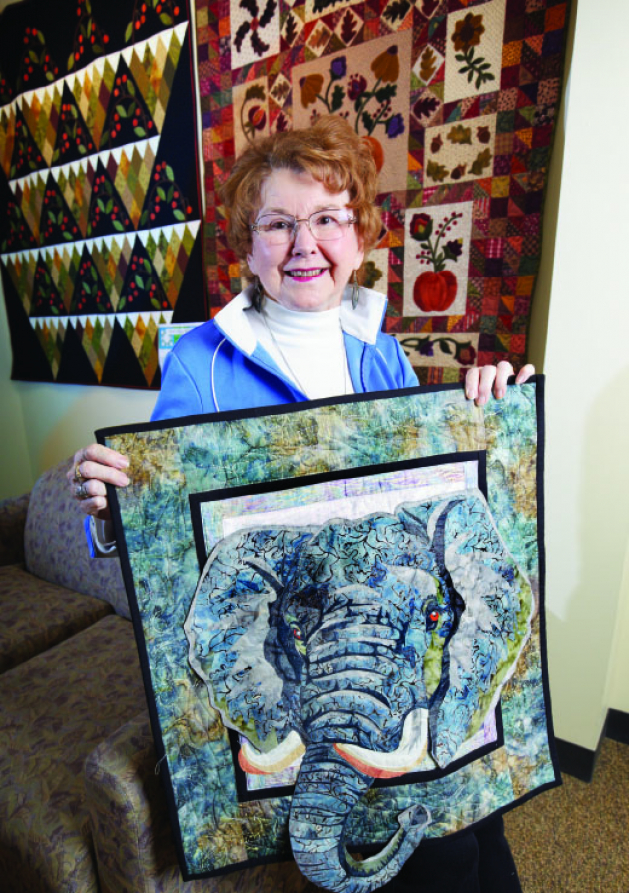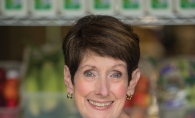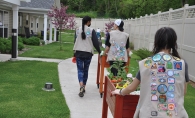
Marilyn Myers remembers cold winters in a small cabin in northern Minnesota, heated only by a wood stove. With no electricity and only an outhouse, it was the epitome of rustic living. And out of necessity, to provide extra warmth at nights, she and her mother would quilt, piecing fabrics from the previous year’s blankets.
“I’m 62 years old, and I remember taking old ratty blankets and used clothes … pulling yarn through and tying them,” Myers says. “We didn’t have much money growing up, and that’s how we had to do it. I learned to sew on a treadle machine. So I never have not quilted.”
Myers’ story isn’t particularly unique, and that’s the point: River Valley Quilters Guild, a group of sewers who gather twice monthly at Woodbury Community Church, welcomes quilters of all ages and experiences, beginner to award-winning advanced. Myers has been a member for about 10 years, having first found the group after a visit toAnn Fabrics to repair her machine turned into a conversation about her sewing room, which subsequently revealed a whole new community of like-minded crafters. Last year she took the reins as head of the group, along with co-president Connie Cocchiarella.
“We do different group projects that help members learn and grow outside of their box,” Myers says, which allows for continuous learning, even for the most experienced members.
Barbara Broberg was one of the first members of the Guild when it was started in 1994 by Caroline Peters and Audrey Mead. (Most of the original members have since moved out of the area or retired.) “It was kind of word of mouth; we talked and asked anyone who had a similar interest, people who have like mindsets,” Broberg recalls of the early days. “Anyone who gets sort of an addiction or a passion about something loves this kind of community.”
Broberg started sewing for her kids, her girls especially, to save money on clothing. “I’ve always had something that I’ve worked on; I’ve kind of flitted from one thing to another to another,” she says. “My first quilt, I saw a pattern for a transportation quilt. My son was about 7 at the time, and looking back at it now I made every mistake possible, but I remember I looked at it, and I loved it, and I said, ‘I’m so good.’ I got such a wonderful feeling that I made something. And it’s the same way now—you’re proud of what you create.”
Textures of a Guild
Like any good community, the Quilters Guild is made up of a variety of different personalities and project types, with one primary goal in mind: camaraderie. Each month, between 50 and 60 members meet to share their current projects, plan attendance at local quilting shows or competitions, and set internal challenges, such as the pizza box challenge (where each participating member creates a “starter” project, with materials and light instructions, and places them in a pizza box that gets passed between members each month, so the end result is effectively a group project that each person has collaborated on and interpreted in their own way; Carbone’s in Woodbury donated actual pizza boxes for this particular challenge.).
“I think a lot of quilters get involved because they like to create,” Broberg says. “As you get older, you need to find things that make you happy and make others happy. That’s quilting for me.”
When people think of quilting, they likely think of bed quilts, those functional adornments for sleeping or snuggling up on a sofa. But that’s just the tip of the proverbial iceberg. Many quilters create their work with the intent that it will be on display, as is the case with many of Broberg’s projects (“I have a wall hanging for every season of the year,” she says). Fabric art including handbags, seat cushions, and even vests and skirts can be quilted. “Some of my favorite projects have been memory quilts, T-shirts made into things, a sports jersey turned into a backpack, bib overalls turned into seat tuffets, and Vera Bradley-esque handbags,” Myers says. And even in the relatively focused genre of bed quilts, there exists a world of pattern designers—like composers of music or authors of books. (McKenna Ryan is one of Broberg’s favorite designers, for the seasonality and “cute fuzzy animal designs,” she says.)
“Our society has become such a throw-away society, so I love to make scrap quilts. I’m always looking for patterns where I can use these scraps up, a three-color quilt, but 500 different materials in it, which I think are far more interesting,” Broberg says. “My hands are giving out on me, so almost everything needs to be done on a machine.”
Patterning the Craft
Indeed, the majority of piecing (sewing together the squares or patches that make up the quilt pattern or image) is machine-sewn these days, as is the quilting itself (the sewing that holds the piecework, batting and backing together). The distinction between these two machined steps is that anyone who can sew can piece a quilt, done on your average sewing machine (priced in the hundreds of dollars range), while long-arm quilting requires a machine that is often half the size of a room and costs in the tens of thousands of dollars.
Myers is one who has a 14-foot table in her basement. “I wish my mom could see me now,” she says, thinking about how far she’s come from that cold cabin in the woods on a treadle machine (the treadle sewing machine goes back almost to the beginning of the technology, and is powered mechanically by a foot pedal).
The Guild creates smaller groups, too, such as those interested in embroidery, applique (ornamental needlework in which pieces of fabric are sewn or stuck onto a large piece of fabric to form pictures or patterns), or those in competition.
There are significantly experienced members of the Guild, the kind who compete on the international level. Myers’ favorite quilt is one example, though she’s humble about it; after it won the Washington County Fair, it automatically was entered in the Minnesota State Fair, where it placed third. “Because it’s won several awards, it’s probably worth $4,000 to $5,000. I keep it on my guest room bed; I use all of my quilts,” she says with a laugh. “It’s all paper-pieced. Judy Niemeier is the designer. It’s purple, and it took me a year and a half to make. I would have never entered it—I don’t make quilts for that, but my grandkids convinced me.” This level of work isn’t cheap: Materials alone for the quilt were $900, Myers estimates.
A Patchwork of Surprises
When asked about the perception residents have of the River Valley Quilters Guild, both Myers and Broberg agree the group is full of surprises. For starters, consider the audience: Broberg says the idea that quilting is a dying art is erroneous. “You’re opening up a new artistic side of it, and younger people in particular seem to appreciate the art of the work,” she says. “That’s the value of getting more people involved: You’re going to create a whole new type of technique, and the sky’s the limit.”
Take bling, for example. Myers says her favorite project of late is a quilt she’s constructing out of formal gowns she purchased at Savers—the richness of the silks and fabrics lend a whole new texture to the project. Another trend is painting directly on the fabric, or adding accessories like beading or other materials found at your local craft store.
Also surprising to many is the amount of giving back that River Valley Quilters Guild does in the region. “Quilters are some of the nicest people you’ll ever meet, because they are givers,” Broberg says.
In March, the Guild donated 10 pieces to Quilts of Valor, a national organization that provides quiltes for veterans who often have some level of post-traumatic stress disorder or experienced injury in combat. Another similar organization is the Wounded Warrior Project: “The goal of these ladies is to comfort these vets, and to honor them, and acknowledge that they served and sacrificed and are greatly appreciated,” Myers says.
Similarly, in August, the Guild hosts a quilt auction to raise money for Camp Knutson in Cross Lake, Minn., whose mission is to offer camp experiences for homeless youth and youth with illnesses or other challenges. In 2018, the group donated 14 items, raising more than $1,500 for the camp.
“Last summer, there were a bunch of tornadoes in South Dakota. One of our members mentioned her hometown was devastated, so we got busy and sent her with quilts for people in need,” Myers says. Hurricanes, too, are a common cause for the Guild to get sewing, and members regularly donate to Harriet Tubman and Dorothy Day societies, as well as local hospitals like St. Joe’s and Children’s in St. Paul, making baby blankets to the specified standards required of such sensitive recipients.
Fabric of the Future
Every two years in October, River Valley Quilters Guild holds a quilt show; in 2018, it took place October 19–20 at Lake Middle School and included everything from raffle quilts and baskets to a boutique store, with a variety of quilted items for sale, to vendors who supply quilters with both ideas and wares.
Additionally, each August and September, the R.H. Stafford Library hangs the Guild’s quilts as part of its rotating art display. Some members sell their quilts, others hang just for the appreciation of the art, but this display is much-anticipated, Myers says. “Next year at the library, we will have the charity quilts (Wounded Warriors and Quilts of Valor, and Shriner’s Hospital, too), so with all of those charity things, we have almost the whole library space taken up,” she says.
Critical to these events, of course, is the addition of new members, who are welcomed at all skill levels, from across the east metro—from Cottage Grove and White Bear Lake, to Newport and Afton. “More and more kids are starting to do this,” Myers says. “Even my youngest grandkid will sit with me at my machine (she’s 5); others have done school projects that involve quilting.”
Ultimately, it’s about creating and growing a shared interest. As Broberg says, “Quilting makes me very happy, and at my stage in life, whatever makes me happy and doesn’t hurt anyone else, I say ‘go for it.’”









